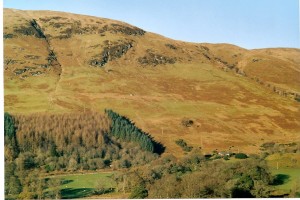
In 8,000 BC, Glendaruel was cut in half by a huge glacier. This glacier fed the valley by melting and created the River Ruel, which gradually would join up with Loch Riddon. As the glacier melted, it increased the volume of water, and the level of the River Ruel, until it reached Loch Riddon. At this time, the River Ruel would be at least ten times broader than it is today. There was effectively a small Loch in the Glen, which would have connected to Loch Riddon. From that time of connection, this melting and joining gave mankind (Mesolithic) the opportunity to come from the South. This would have been both land and sea. Gradually as the temperature rose sufficiently, Mesolithic man would be enabled to move North.
These Mesolithic people who came to the Glen were identical to us – they were real people just like us. They would have come with a formed way of life. They lived as hunter-gatherers with seaman-ship skills, orientated around gathering fish, wild forest animals, and plants. As the temperature rose, the Glen was filled with woodland, from South to North as the receding glacier left. The next influence on the Glen and the Ruel came from Neolithic farmers of the South and their ideas, and Glendaruel was a melting pot for the two cultures. The skills of farming cattle and sheep, and taming animals, would come into contact with the forest dwelling people, and their habits.
The Neolithic people in their turn would become influenced from the South, and both the East and West, ideas and people with new technologies and customs would then come in, especially with metals. The influence therefore came from people with skills in copper and tin.
Material influences in metals, cultures, with the development of technology in bronze were the next wave in social evolution. With all these influences on the Glen, archeology now moves into history.
Charles McLaughlin, August 2013.